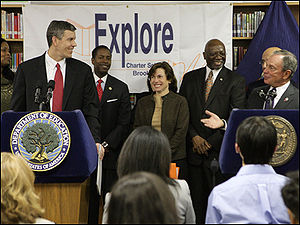
- Image via Wikipedia
MICHAEL MULGREW is an affable former Brooklyn vocational-high-school teacher who took over last year as head of New York City’s United Federation of Teachers when his predecessor, Randi Weingarten, moved to Washington to run the national American Federation of Teachers. Over breakfast in March, we talked about a movement spreading across the country to hold public-school teachers accountable by compensating, promoting or even removing them according to the results they produce in class, as measured in part by student test scores. Mulgrew’s 165-page union contract takes the opposite approach. It not only specifies everything that teachers will do and will not do during a six-hour-57 ½-minute workday but also requires that teachers be paid based on how long they have been on the job. Once they’ve been teaching for three years and judged satisfactory in a process that invariably judges all but a few of them satisfactory, they are ensured lifetime tenure.
Next to Mulgrew was his press aide, Richard Riley. “Suppose you decide that Riley is lazy or incompetent,” I asked Mulgrew. “Should you be able to fire him?”
“He’s not a teacher,” Mulgrew responded. “And I need to be able to pick my own person for a job like that.” Then he grinned, adding: “I know where you’re going, but you don’t understand. Teachers are just different.”
That is the kind of story that makes Jon Schnur smile. Schnur, who runs a Manhattan-based school-reform group called New Leaders for New Schools, sits informally at the center of a network of self-styled reformers dedicated to overhauling public education in the United States. They have been building in strength and numbers over the last two decades and now seem to be planted everywhere that counts. They are working in key positions in school districts and charter-school networks, legislating in state capitals, staffing city halls and statehouses for reform-minded mayors and governors, writing papers for policy groups and dispensing grants from billion-dollar philanthropies like the Bill and Melinda Gates Foundation. Bill Gates, along with Education Secretary Arne Duncan; Teach for America’s founder, Wendy Kopp; and the New York City schools chancellor Joel Klein could be considered the patron saints of the network.
Over the last several months, Schnur and the well-positioned fellow travelers on his speed dial have seen the cause of their lives take center stage. Why the sudden shift from long-simmering wonk debate to political front burner? Because there is now a president who, when it comes to school reform, really does seem to be a new kind of Democrat — and because of a clever idea Schnur had last year to package what might otherwise have been just another federal grant program into a media-alluring, if cheesy-sounding, contest called Race to the Top. It has turned a relatively modest federal program (the $4.3 billion budget represents less than 1 percent of all federal, state and local education spending) into high-yield leverage that could end up overshadowing health care reform in its impact and that is already upending traditional Democratic Party politics. The activity set off by the contest has enabled Schnur’s network to press as never before its frontal challenge to the teachers’ unions: they argue that a country that spends more per pupil than any other but whose student performance ranks in the bottom third among developed nations isn’t failing its children for lack of resources but for lack of trained, motivated, accountable talent at the front of the class.
Related articles by Zemanta
- Getting Rid of Bad Teachers (roomfordebate.blogs.nytimes.com)
- States push teacher pay based on performance (msnbc.msn.com)
- Obama knows teachers must try harder | Niall Stanage (guardian.co.uk)
- Editorial: A Deal for Better Schools (nytimes.com)







![Reblog this post [with Zemanta]](http://img.zemanta.com/reblog_b.png?x-id=01607c32-ce47-45dc-aa33-3b0124ba677b)
